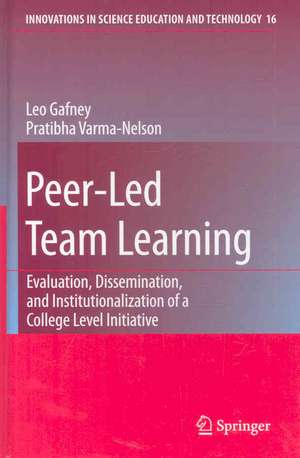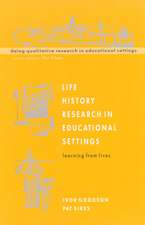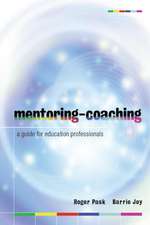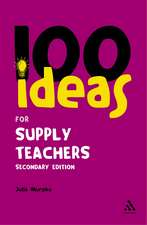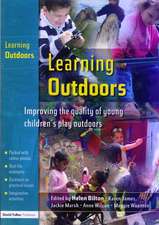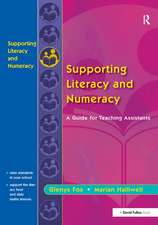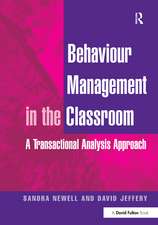Peer-Led Team Learning: Evaluation, Dissemination, and Institutionalization of a College Level Initiative: Innovations in Science Education and Technology, cartea 16
Autor Leo Gafney, Pratibha Varma-Nelsonen Limba Engleză Hardback – 21 iul 2008
| Toate formatele și edițiile | Preț | Express |
|---|---|---|
| Paperback (1) | 634.18 lei 6-8 săpt. | |
| SPRINGER NETHERLANDS – 22 noi 2010 | 634.18 lei 6-8 săpt. | |
| Hardback (1) | 640.24 lei 6-8 săpt. | |
| SPRINGER NETHERLANDS – 21 iul 2008 | 640.24 lei 6-8 săpt. |
Din seria Innovations in Science Education and Technology
- 24%
 Preț: 732.43 lei
Preț: 732.43 lei -
 Preț: 394.87 lei
Preț: 394.87 lei - 15%
 Preț: 636.80 lei
Preț: 636.80 lei -
 Preț: 390.63 lei
Preț: 390.63 lei -
 Preț: 386.22 lei
Preț: 386.22 lei -
 Preț: 381.98 lei
Preț: 381.98 lei -
 Preț: 383.93 lei
Preț: 383.93 lei -
 Preț: 391.02 lei
Preț: 391.02 lei -
 Preț: 397.16 lei
Preț: 397.16 lei - 15%
 Preț: 639.41 lei
Preț: 639.41 lei - 18%
 Preț: 947.85 lei
Preț: 947.85 lei - 18%
 Preț: 962.66 lei
Preț: 962.66 lei -
 Preț: 379.86 lei
Preț: 379.86 lei - 15%
 Preț: 647.59 lei
Preț: 647.59 lei - 15%
 Preț: 649.39 lei
Preț: 649.39 lei -
 Preț: 393.35 lei
Preț: 393.35 lei - 15%
 Preț: 641.53 lei
Preț: 641.53 lei - 18%
 Preț: 900.94 lei
Preț: 900.94 lei - 18%
 Preț: 1000.70 lei
Preț: 1000.70 lei -
 Preț: 386.81 lei
Preț: 386.81 lei -
 Preț: 388.13 lei
Preț: 388.13 lei -
 Preț: 383.93 lei
Preț: 383.93 lei - 15%
 Preț: 585.73 lei
Preț: 585.73 lei -
 Preț: 394.87 lei
Preț: 394.87 lei - 18%
 Preț: 891.93 lei
Preț: 891.93 lei -
 Preț: 392.97 lei
Preț: 392.97 lei
Preț: 640.24 lei
Preț vechi: 753.22 lei
-15% Nou
Puncte Express: 960
Preț estimativ în valută:
122.53€ • 127.45$ • 101.15£
122.53€ • 127.45$ • 101.15£
Carte tipărită la comandă
Livrare economică 14-28 aprilie
Preluare comenzi: 021 569.72.76
Specificații
ISBN-13: 9781402061851
ISBN-10: 1402061854
Pagini: 168
Ilustrații: XII, 156 p.
Dimensiuni: 155 x 235 x 22 mm
Greutate: 0.41 kg
Ediția:2008
Editura: SPRINGER NETHERLANDS
Colecția Springer
Seria Innovations in Science Education and Technology
Locul publicării:Dordrecht, Netherlands
ISBN-10: 1402061854
Pagini: 168
Ilustrații: XII, 156 p.
Dimensiuni: 155 x 235 x 22 mm
Greutate: 0.41 kg
Ediția:2008
Editura: SPRINGER NETHERLANDS
Colecția Springer
Seria Innovations in Science Education and Technology
Locul publicării:Dordrecht, Netherlands
Public țintă
ResearchCuprins
Introduction: Educational reform at the college level and overview of the project.Chapter 1: Plan and Context of the Study. This chapter first describes Peer-Led Team Learning (PLTL) and the use of problem-solving workshops as an integral part of a science course. The research questions and methodology for the entire study are presented. The adoption of workshops is discussed in the context of educational reform.Chapter 2: Development and Implementation of Peer-Led Team Learning. The six critical components that form the PLTL model are explained. The experiences of students and workshop leaders are presented as captured in surveys, interviews, and site visits. The results of numerous comparative studies of student performance are presented. The use of the critical components in evaluation is explained with examples.Chapter 3: Dissemination of Peer-Led Team Learning. The dissemination plan of PLTL is explained. Dissemination is then analyzed in part using Everett M. Rogers ideas and categories. The chapter also discusses issues rooted in the role of the college professor, and factors involving comfort with or resistance to change.Chapter 4: Adopting Peer-Led Team Learning and the Limits of Adaptability. Adoption of the method is studied based on an analysis of 70 mini grants. These grants of $5000, matched by the institution, enabled professors to adopt PLTL. Site visits and interviews generated additional data and insights about issues in adopting and adapting the method. Chapter 5: Sustainability. Based on surveys, interviews, site visits, and a phone survey of administrators, hypotheses are developed about criteria for judging sustainability. These hypotheses are further reviewed and tested using an on-line survey of faculty adopters. Chapter 6: Study of FormerLeaders. With more than 10 years of history, an on-line survey was used to gather data about the impact of leading workshops on the leaders’ futurestudies and early career experiences. The analysis, based on 119 respondents, reveals a variety of benefits as the leaders reflect on PLTL experiences. Chapter 7: Impact of the PLTL on Minority Students. The history of efforts to support and encourage under-represented minority students in the sciences is described. Data on the impact of PLTL is presented. General principles for successful academic support are explored.Chapter 8: The Goals of Higher Education and New Paradigms. PLTL as a teaching/learning initiative is discussed in the institutional setting of higher education and from the perspective of current pedagogical theory and practice. Chapter 9: Summary and Issues. This chapter reviews the more significant issues in the three areas of implementation, dissemination, and institutionalization. Special attention is paid to team learning, faculty involvement in educational initiatives, and stages in dissemination. Requirements and obstacles to institutionalization are discussed. ReferencesAppendix: Evaluation data in the text: location of tables and summaries.
Recenzii
From the reviews:
This book is a must read for anyone writing their first proposal for NSF's TUES (formerly CCLI) program!
Overall, I believe that this book will become an important resource for science, technology, engineering, and mathematics (STEM) faculty because Gafney and Varma-Nelson offer insight in addition to knowledge they have gained. Most importantly, this book should have broad appeal because the authors are able to get their points across with clarity and rigor without getting bogged down with too much jargon.
Gautam Bhattacharyya teaches Chemistry at Clemson University, Clemson, SC, USA
“The authors’ focus is to describe the mechanics of developing an initiative locally, expanding it to a national level, and evaluating its impacts on multiple sets of stakeholders. … the goal of this book is to offer a ‘big picture’ account; thus, readers must consult individual papers to get details of the studies. … Overall, I believe that this book will become an important resource for science, technology, engineering, and mathematics (STEM) faculty … .” (Gautam Bhattacharyya, Journal of Chemical Education, December, 2010)
This book is a must read for anyone writing their first proposal for NSF's TUES (formerly CCLI) program!
Overall, I believe that this book will become an important resource for science, technology, engineering, and mathematics (STEM) faculty because Gafney and Varma-Nelson offer insight in addition to knowledge they have gained. Most importantly, this book should have broad appeal because the authors are able to get their points across with clarity and rigor without getting bogged down with too much jargon.
Gautam Bhattacharyya teaches Chemistry at Clemson University, Clemson, SC, USA
“The authors’ focus is to describe the mechanics of developing an initiative locally, expanding it to a national level, and evaluating its impacts on multiple sets of stakeholders. … the goal of this book is to offer a ‘big picture’ account; thus, readers must consult individual papers to get details of the studies. … Overall, I believe that this book will become an important resource for science, technology, engineering, and mathematics (STEM) faculty … .” (Gautam Bhattacharyya, Journal of Chemical Education, December, 2010)
Textul de pe ultima copertă
This book is a real-world study of Peer-Led Team Learning (PLTL), a method in which undergraduates work together, under the guidance of a peer leader, in course-connected workshops. PLTL is intended to complement lecture.
The text explains how the method evolved into a teaching/learning model. The evaluation uncovered six critical components for successful implementation. Evaluation at each new site looked at implementation, comparing methods, materials, training, and organizational arrangements with what had been found to work effectively. Those disseminating the model used the critical components to frame their presentations. Dissemination of the method is carefully documented and analyzed.
Evaluation of the program’s effectiveness was shared. Instructors compared grades of classes or cohorts of students with and without PLTL, with different kinds of controls. The external evaluator measured the quality of implementation, student satisfaction, the impact on leaders, and other factors. Finally, this study looks closely at institutionalization: the essential factors necessary for a program’s sustainability. The evaluation explained in this text is transportable to other programs and pedagogies.
"Peer-Led Team Learning (PLTL) is one of the success stories resulting from the National Science Foundation's investment in educational innovation. Gafney and Varma-Nelson provide a coherent, tour-de-force look at the in-depth research that has been carried out, not only to understand the effect of PLTL on student learning, but also to understand the nature of the pedagogical method itself. This monograph is a jam-packed, one-stop destination for anyone who wants to learn what it means to understand a widespread pedagogical development in post-secondary science education."
Brian Coppola, University of Michigan
The text explains how the method evolved into a teaching/learning model. The evaluation uncovered six critical components for successful implementation. Evaluation at each new site looked at implementation, comparing methods, materials, training, and organizational arrangements with what had been found to work effectively. Those disseminating the model used the critical components to frame their presentations. Dissemination of the method is carefully documented and analyzed.
Evaluation of the program’s effectiveness was shared. Instructors compared grades of classes or cohorts of students with and without PLTL, with different kinds of controls. The external evaluator measured the quality of implementation, student satisfaction, the impact on leaders, and other factors. Finally, this study looks closely at institutionalization: the essential factors necessary for a program’s sustainability. The evaluation explained in this text is transportable to other programs and pedagogies.
"Peer-Led Team Learning (PLTL) is one of the success stories resulting from the National Science Foundation's investment in educational innovation. Gafney and Varma-Nelson provide a coherent, tour-de-force look at the in-depth research that has been carried out, not only to understand the effect of PLTL on student learning, but also to understand the nature of the pedagogical method itself. This monograph is a jam-packed, one-stop destination for anyone who wants to learn what it means to understand a widespread pedagogical development in post-secondary science education."
Brian Coppola, University of Michigan
Caracteristici
A comprehensive analysis of program development, implementation, dissemination, and institutionalization A study over a 10 year period, with data from dozens of institutions, scores of faculty, and hundreds of students A model that can be used for the development and study of other programs Grounded in solid theory, with a thoroughly practical approach Useful to administrators (Chairs, Deans and Provosts) who evaluate new methods of teaching and who wish to evaluate and reward faculty engaged in the scholarship of teaching and learning
